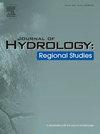South African soil, land cover and weather generator file databases for SWAT applications
IF 4.7
2区 地球科学
Q1 WATER RESOURCES
引用次数: 0
Abstract
Study region
South Africa.
Study focus
The focus of the study is to develop soil, land cover and weather generator file datasets for Soil and Water Assessment Tool (SWAT) applications in South Africa. The first objective was to format national datasets for use as baseline to run the SWAT model in South Africa. The second objective was to evaluate the performance of the baseline input data by applying the national datasets in four (previously simulated) research catchments.
New hydrological insights for the region
The input datasets comprise of geo-spatial datasets at a national scale to run ArcSWAT or QSWAT (graphical user interface for SWAT in ArcGIS and SWAT+ in QGIS, respectively) in South Africa including: SWAT catchment outline data (tertiary and quaternary); Land cover maps at 20–30 m resolution including South African National Land Cover (2014, 2018, 2020) linked to SWAT land cover codes; A soil map with SWAT attribute data derived from pedotransfer functions of the Land Type Database of South Africa useable at a scale of 1:250,000; Weather statistics (WGN) files for 12 weather stations obtained from the Agricultural Research Council in South Africa. The national baseline data is an important step forward in hydrological modelling by assisting modellers to set-up and run the SWAT model in South Africa.
求助全文
约1分钟内获得全文
求助全文
来源期刊

Journal of Hydrology-Regional Studies
Earth and Planetary Sciences-Earth and Planetary Sciences (miscellaneous)
CiteScore
6.70
自引率
8.50%
发文量
284
审稿时长
60 days
期刊介绍:
Journal of Hydrology: Regional Studies publishes original research papers enhancing the science of hydrology and aiming at region-specific problems, past and future conditions, analysis, review and solutions. The journal particularly welcomes research papers that deliver new insights into region-specific hydrological processes and responses to changing conditions, as well as contributions that incorporate interdisciplinarity and translational science.
 求助内容:
求助内容: 应助结果提醒方式:
应助结果提醒方式:


